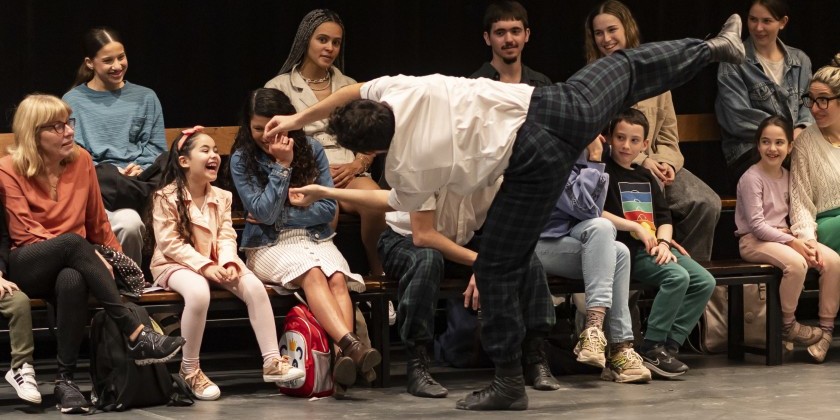IMPRESSIONS: Curet Performance Project’s “Aspectos” at Center for Performance Research

November 1, 2019
Artistic Director: Megan Curet
Dancers: Melani De Guzman, Kristen Hedberg, Maria Vittoria Villa, Megan Curet, Ann-Marie Gover, Fernando Moya Delgado
In the Center for Performance Research’s lobby, friends meet to sip wine and chat. Suddenly a man rushes past, pushing a table while clamoring in clipped Spanish. He sits, crosses himself, and then prays. Although I don’t know the words, I understand performer Fernando Moya Delgado’s body language. With fingers together and shaking toward the sky, the cadence of his speech increases. I catch words like “madre” and “familia.”
Two women in flesh-colored bras emerge, pushing and shoving dancer and Artistic Director Megan Curet to the ground. Using black markers, they write words on her skin as Delgado continues to pray. “Puta. Whore,” the duo hisses at her.

The dancers leave her crumpled on the floor. Another woman wipes the words away with a wet cloth, her touch reverent and kind. With stomping feet and an undulating torso, Curet pulls on a long skirt and slowly begins circling her body along a curving pathway. Spiraling hips, pushing arms, and shaking hands outline Curet’s inquiry to undo the culturally embedded guilt and shame about the ways women are “supposed” to behave.
This is Negra Con Tumbao, the first of four movement narratives that combine into the evening-length Aspectos. The work seamlessly melds traditions practiced in Curet’s family’s religion of Santeria, ancestral music, and dancing in her childhood home to examine who she and her community are today. Employing a blend of classical modern dance and Puerto Rican-inspired movements, Curet creates an immersive environment where the universal language of the body can be read and experienced by everyone.

As we follow Curet from the lobby into the performance space, Delgado transforms the table from a church pew to a dining table. A family gathers, English and Spanish layering over each other in a repetitive loop. Madre Mia starts out accusatory before softening into giggles.
“You can’t talk to people like that!”
“It’s ok.”
“Where’s my pacifier?”
The performers storm from the family dinner table to dance in unison, their relationships defined by love but imbued with dysfunction.

Sistema, a piece for four women, opens with Ann-Marie Gover asking, “What do you see when you see me?” As she lists her roles as a woman — performer, daughter, hard worker — the others perform individualized gestures that reinforce feelings of disconnection and isolation. In a performance space outlined with a geometric pattern on the floor, they sweep and flow along the constricted pathways to highlight the confinement of the systems we live within.
As Gover, Curet, Kristen Hedberg, and Maria Vittoria Villa move closer and closer together, their interactions become aggressive. Breaking out into less restrictive formations, their solidarity as women emerges. Technical battements and fouettés dissolve into spinal undulations, their freedom from oppression becoming evident. The question “What do you see when you see me?” is repeated as the women stomp and clap. The answer is that they are all the things we see and also all the things we cannot see.

In Isla, Curet’s response to Hurricane Maria, the writhing torsos and bodies crumbling to the floor serve as visceral reminders of collapsed rooftops and devastated homes. Dancers melt and roll around like debris to evoke the unanswered questions and secrecy surrounding the storm’s annihilation. When they billow their spines like waves and pound the ground with their palms like water slapping rocks, we see resiliency and defiance in the face of tragedy.
“This is the home of a people, and these are my people,” Curet asserts in the program notes.












